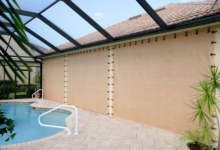
5 Signs It’s Time for a Siding Replacement on Your Home
In 2020, the global siding market was valued at approximately $72.99 billion and was expected to hit $77.53 billion by 2021. These statistics are proof of the high demand for sidings, as more property owners realize the unmatched benefits of this innovation.
Siding protects your home from the elements and can impact its curb appeal. Moreover, siding boosts your home’s energy efficiency.
However, siding can become worn and damaged over time, making it less effective at doing its job. When this happens, it’s time to consider a siding replacement, notes Service Star Realty company. Not sure if it’s time to replace the siding?
Here are five signs that indicate it’s time to replace home siding.
Table of Contents
1. Your Siding Is Cracked or Chipped
Cracks and chips can let water and moisture into your home, leading to severe problems like mold and mildew. In extreme cases, cracks and chips can also weaken the structure of your siding, making it more susceptible to damage from high winds and other severe weather conditions.
There are a few different things that can cause the siding to crack, including:
The Impact of Hail or Debris
Hail and debris can cause the siding to crack and chip. If you live in an area prone to severe weather, it’s essential to inspect your siding regularly for any damage.
Extreme Temperature Changes
Sudden temperature changes can cause the siding to contract and expand, leading to cracking. This is more likely to happen in areas with large temperature swings.
Poor Quality Siding
Poor quality siding is more likely to crack and chip than high-quality siding. If your siding is made from cheap material, it may be time to replace it with something more durable.
If you notice even the tiniest cracks on your sidings, you should contact reputable contractors such as James Hardie Siding experts immediately for an inspection. The professional will recommend the best solution based on the extent of damages.
2. Your Siding Is Warped
Warping siding can cause several problems, including letting water and moisture into your home. Warping can also make your siding more susceptible to damage from high winds, so replacing siding is your best option.
You can protect your siding from prematurely warping to extend its life. For starters, invest in the best quality siding. Then, ensure the material can survive extreme weather conditions and elements.
Besides quality material, ensure the proper siding installation. Hire a reputable contractor for a quality work guarantee.
Most importantly, protect your siding from extreme temperature, especially if you live in an area with large temperature swings. One way to do this is to use insulation siding. Insulating siding helps regulate the temperature of your home, making it less likely to be affected by extreme temperature changes.
3. Your Energy Bills Are Rising
If your energy bills are increasing, it could be a sign that your siding is no longer doing its job. Siding helps insulate your home and keep the heat in during the winter and the cool air in the summer.
Also, suppose your siding is damaged or not correctly installed. The siding may not be providing adequate insulation for your home, leading to higher energy bills as your home tries to compensate for the loss of insulation.
In addition, if your siding is cracked or damaged, it may be letting drafts into your home. These drafts can make your home feel colder in the winter and hotter in the summer, causing your energy bills to increase.
If you notice an uptick in your energy bills, it’s essential to have your siding inspected to see if it needs to be repaired or replaced.
4. Your Siding Has Mold and Mildew Growth
Mold can ruin the curb appeal and integrity of your property. Furthermore, mold and mildew are a threat to your household’s health. If left untreated, mold can spread to other parts of your home and cause further damage.
Therefore, you should be on the lookout for potential signs of mold and mildew on your sidings, which include:
Discoloration: Mold and mildew manifest as black, brown, or green streaks on your siding. You can easily confuse the stains for dirt, so it’s best to let an expert inspect the sidings to establish if you have a mold problem.
Deterioration: Mold and mildew can cause the siding to deteriorate. If you notice that your siding is starting to crumble or fall apart, it may be due to mold or mildew growth.
Unpleasant odor: Mold and mildew often have an unpleasant odor. If you notice a musty smell coming from your siding, it may be due to mold or mildew.
Mold and mildew are primarily common in humid conditions. As such, if you live in a region with a humid climate, consider using a dehumidifier to remove excess moisture from the air.
Similarly, if you have had the sidings for years, there is the likelihood that the siding has been damaged by water, thus high chances of mold growth. In such a case, it’s best to contact an expert for replacement siding installation.
5. Your Siding Is Faded
Fading siding can make your home look old and worn. Exposure to sunlight is the number one cause of fading siding.
In addition, the sun’s ultraviolet (UV) rays can cause the siding to discolor over time. Therefore, if you live in an area with a lot of sun exposure, choosing a siding material that’s resistant to fading is vital.
Poor quality siding material and improper installation are the other possible causes of fading siding.
Similarly, if the siding is not installed correctly, it may not be adequately sealed and protected from the elements. This can allow moisture and sunlight to enter the siding, causing it to discolor and fade over time.
Siding Replacement for an Efficient Property
Above are just a few signs that it may be time for a siding replacement on your home. If you notice any of these problems with your siding, contact a siding contractor for an inspection. A siding contractor can determine if you need to replace exterior siding or if you simply need a repair.
For more helpful guides like this, keep refreshing our website for updates.








